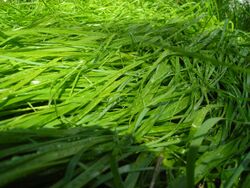Biology:Hierochloe odorata
| Hierochloe odorata | |
|---|---|

| |
| Scientific classification | |
| Kingdom: | Plantae |
| Clade: | Tracheophytes |
| Clade: | Angiosperms |
| Clade: | Monocots |
| Clade: | Commelinids |
| Order: | Poales |
| Family: | Poaceae |
| Genus: | Hierochloe |
| Species: | H. odorata
|
| Binomial name | |
| Hierochloe odorata | |
| Synonyms | |
Hierochloe odorata or Anthoxanthum nitens[1] (commonly known as sweet grass, manna grass, Mary’s grass or vanilla grass, and as holy grass in the United Kingdom ,[3] bison grass e.g. by Poland vodka producers[4]) is an aromatic herb native to northern Eurasia and North America. It is considered sacred by many Indigenous peoples in Canada and the United States. It is used as a smudge in herbal medicine and in the production of distilled beverages (e.g., Żubrówka, Wisent). It owes its distinctive sweet scent to the presence of coumarin.
This variety of grass is distinct from the species commonly known as buffalo grass in Australia and the United States (Stenotaphrum secundatum and Bouteloua dactyloides, respectively).
Characteristics
Hierochloe odorata is a very hardy perennial, able to grow in the Arctic Circle. Its leaves do not have rigid stems, so only grow to about 20 cm (7.9 in) in height, and then the leaves grow outward horizontally to 100 cm (39 in) long or more, by late summer. The base of the leaf, just below the soil surface, is broad and white, without hairs; the underside of the leaf is shiny and glabrous. In the wild, the bases of the leaves are frequently purple-red colored, and this indicates a phosphorus-deficient soil.[5]
There are several strains of sweetgrass: a regular strain that can be harvested once or twice a year, and a naturally occurring polyploid strain, which is much faster growing and can be harvested three to five times a year.[5]
Two chemicals found in sweetgrass, phytol and coumarin, repel mosquitoes.[6]
Taxonomy
The name Hierochloe odorata is from the Greek and Latin. Hierochloe means "holy grass" and odorata means "fragrant". Some authors include Hierochloe in Anthoxanthum; in this case this species is given the epithet nitens to avoid confusion with a different species, Anthoxanthum odoratum, sweet vernal grass.[1]
Propagation
Propagation is easiest by cutting out plugs from established plants. Grown in sun or partial shade, they do not like drought. Seeds are usually not viable, or if they are, take two to three years to develop a robust root system.
Distribution
In North America Hierochloe odorata occurs in southern Canada, northern Great Plains/Rocky Mountains and northwest of U.S., and New England.[7] In continental Europe it occurs north from Switzerland. There is only one site in Ireland, and it is recorded in four counties of Scotland and one in north-eastern England.[8]
Uses
The plant is harvested by cutting grass in early to late summer at the desired length. Hierochloe odorata harvested after the first frost has little or no scent and is less desirable for basketry. Basketweavers sun-dry cut sweet grass until it is dry and brittle. The brittle form of sweet grass must be soaked in warm water until it becomes pliable. The pliable grass is typically braided into thick threads and then redried for use.
European traditions
Holy grass was strewn before church doors on saints' days in northern Europe, presumably because of the sweet smell that arose when it was trodden on. It was used in France to flavor candy, tobacco, soft drinks, and perfumes. In Europe, the species Hierochloe alpina is frequently substituted or used interchangeably. In Russia, it was used to flavor tea. It is still used in flavored vodka, such as the Polish Żubrówka.
In Finnmark, Sámi peoples have braided and dried the grass (háissasuoidni in Northern Sámi) to use as a perfume, either directly or by storing it with clothes.[9]
Indigenous traditions (North America)
Sweet grass is widely used by Indigenous peoples from many different Nations in North America. Among many of the Plains Indians it is considered one of the "four sacred medicines".[10] Though being used for many purposes, its main two purposes for many tribes are to attract good spirits, as well as being used as a natural mosquito repellent. It is also known as the "Hair of Mother Earth".[11] Robin Wall Kimmerer writes among other things about sweetgrass and its sustainable harvesting in her book Braiding Sweetgrass.[12]
References
- ↑ 1.0 1.1 1.2 Hope, Tom, & Gray, Alan, Grasses of the British Isles: BSBI Handbook No. 13, Botanical Society of the British Isles, 2009, p. 311. ISBN:978-0-901158-42-0.
- ↑ "Hierochloe arctica J.Presl | Plants of the World Online | Kew Science" (in en). https://powo.science.kew.org/taxon/urn:lsid:ipni.org:names:122528-2.
- ↑ (xls) BSBI List 2007, Botanical Society of Britain and Ireland, https://bsbi.org/download/3542/, retrieved 2014-10-17
- ↑ Krasińska, M.; Krasińska, Z. (2013). "Food and Use of the Environment". European Bison. Springer Berlin Heidelberg. pp. 157–179. doi:10.1007/978-3-642-36555-3_14. ISBN 978-3-642-36554-6.
- ↑ 5.0 5.1 Sweetgrass Growing information. Redwood City Seed Company. http://www.ecoseeds.com/sweetgrass.html
- ↑ "Mosquito-repelling chemicals identified in traditional sweetgrass". http://phys.org/news/2015-08-mosquito-repelling-chemicals-traditional-sweetgrass.html.
- ↑ Hierochloe odorata (L.) P. Beauv., USDA PLANTS
- ↑ "Hierochloe odorata". https://www.brc.ac.uk/plantatlas/plant/hierochloe-odorata.
- ↑ Alm, Torbjørn (23 December 2015). "Scented grasses in Norway—identity and uses". Journal of Ethnobiology and Ethnomedicine 11: 83. doi:10.1186/s13002-015-0070-y. ISSN 1746-4269. PMID 26701261.
- ↑ "Four Sacred Medicines | American Indian Health Service of Chicago, Inc". https://aihschgo.org/four-sacred-medicines/#:~:text=The%20Four%20Sacred%20Medicines%20(Tobacco,well%2Dbeing%20of%20native%20peoples.
- ↑ "NativeTech: Native American Uses for Sweetgrass". http://www.nativetech.org/plants/sweetgrass.html.
- ↑ Kimmerer, Robin Wall (2020). Braiding Sweetgrass: Indigenous Wisdom, Scientific Knowledge, and the Teachings of Plants. London: Penguin. ISBN 978-0-141-99195-5.
External links
Wikidata ☰ Q161162 entry
 |


